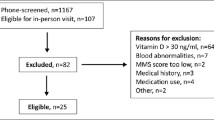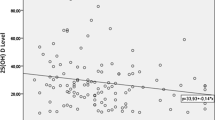Abstract
Introduction
The objectives were:(1) to validate a quantitative balance assessment method for fall risk prediction; (2) to investigate whether the effect of vitamin D and calcium on the risk of falling is mediated through postural or dynamic balance, as assessed by this method.
Materials and methods
A secondary analysis of a double blind randomized controlled trial was employed, which included 64 institutionalized elderly women with complete balance assessment (age range: 65–97; mean 25–hydroxyvitamin D levels: 16.4 ng/ml (SD ±9.9). Participants received 1,200 mg calcium plus 800 IU cholecalciferol (n=33) or 1,200 mg calcium (n=31) per day over a 3-month treatment period. Using an electronic device attached to the lower back of the participant, balance was assessed as the degree of trunk angular displacement and angular velocity during a postural task (standing on two legs, eyes open, for 20 s) and a dynamic task (get up from a standard height chair with arm rests, sit down and then stand up again and remain standing).
Results
It was found that both postural and dynamic balance independently and significantly predicted the rate of falling within the 3-month follow-up. Vitamin D plus calcium reduced the rate of falls by 60% [relative risk (RR)=0.40; 95% CI: 0.17, 0.94] if compared with calcium alone. Once postural and dynamic balance were added to the regression analysis, they both attenuated the effect of vitamin D plus calcium on the rate of falls. For postural balance, the RR changed by 22% from 0.40 to 0.62 if angular displacement was added to the model, and by 9% from 0.40 to 0.49 if angular velocity was added. For dynamic balance, it changed by 1% from 0.40 to 0.41 if angular displacement was added, and by 14% from 0.40 to 0.54 if angular velocity was added.
Discussion
Thus, balance assessment using trunk angular displacement is a valid method for the prediction of falls in older women. Of the observed 60% reduction in the rate of falls by vitamin D plus calcium supplementation compared with calcium alone, up to 22% of the treatment effect was explained by a change in postural balance and up to 14% by dynamic balance.


Similar content being viewed by others
References
Tinetti ME, Williams CS (1998) The effect of falls and fall injuries on functioning in community-dwelling older persons. J Gerontol A Biol Sci Med Sci 53(2):M112–119
Tinetti ME, Williams CS (1997) Falls, injuries due to falls, and the risk of admission to a nursing home. N Engl J Med 337(18):1279–1284
Tinetti ME, Speechley M, Ginter SF (1988) Risk factors for falls among elderly persons living in the community. N Engl J Med 319(26):1701–1707
Sattin RW, Lambert Huber DA, DeVito CA et al (1990) The incidence of fall injury events among the elderly in a defined population. Am J Epidemiol 131(6):1028–1037
Bischoff–Ferrari HA, Dawson–Hughes B, Willett CW et al (2004) Effect of vitamin D on falls: a meta-analysis. JAMA 291(16):1999–2006
Boland R (1986) Role of vitamin D in skeletal muscle function. Endocr Rev 7:434–447
Bischoff HA, Stahelin HB, Dick W et al. (2003) Effects of vitamin D and calcium supplementation on falls: a randomized controlled trial. J Bone Miner Res 18(2):343–351
Bischoff–Ferrari HA, Borchers M, Gudat F, Durmuller U, Stahelin HB, Dick W (2004) Vitamin D receptor expression in human muscle tissue decreases with age. J Bone Miner Res 19(2):265–269
Glerup H, Mikkelsen K, Poulsen L et al. (2000) Hypovitaminosis D myopathy without biochemical signs of osteomalacic bone involvement. Calcif Tissue Int 66(6):419–424
Pfeifer M, Begerow B, Minne HW, Abrams C, Nachtigall D, Hansen C (2000) Effects of a short-term vitamin D and calcium supplementation on body sway and secondary hyperparathyroidism in elderly women. J Bone Miner Res 15(6):1113–1118
Bischoff–Ferrari HA, Dietrich T, Orav EJ et al. (2004) Higher 25–hydroxyvitamin D concentrations are associated with better lower-extremity function in both active and inactive persons aged > or =60 y. Am J Clin Nutr 80(3):752–758
Nevitt MC, Cummings SR, Kidd S, Black D (1989) Risk factors for recurrent nonsyncopal falls. A prospective study. Jama 261(18):2663–2668
Buchner DM, Hornbrook MC, Kutner NG et al. (1993) Development of the common data base for the FICSIT trials. J Am Geriatr Soc 41(3):297–308
Allum JH, Adkin AL (2003) Improvements in trunk sway observed for stance and gait tasks during recovery from an acute unilateral peripheral vestibular deficit. Audiol Neurootol 8(5):286–302
Allum JH, Zamani F, Adkin AL, Ernst A (2002) Differences between trunk sway characteristics on a foam support surface and on the Equitest ankle–sway–referenced support surface. Gait Posture 16(3):264–270
Gill J, Allum JH, Carpenter MG et al. (2001) Trunk sway measures of postural stability during clinical balance tests: effects of age. J Gerontol A Biol Sci Med Sci 56(7):M438–447
de Hoon EW, Allum JH, Carpenter MG et al. (2003) Quantitative assessment of the stops walking while talking test in the elderly. Arch Phys Med Rehabil 84(6):838–842
Sjostrom H, Allum JH, Carpenter MG, Adkin AL, Honegger F, Ettlin T (2003) Trunk sway measures of postural stability during clinical balance tests in patients with chronic whiplash injury symptoms. Spine 28(15):1725–1734
Lord SR, Clark RD, Webster IW (1991) Postural stability and associated physiological factors in a population of aged persons. J Gerontol 46(3):M69–76
Rosner B (2000) Fundamentals of Biostatistics, 5th edn, pp 98–105
Campbell AJ, Reinken J, Allan BC, Martinez GS (1981) Falls in old age: a study of frequency and related clinical factors. Age Ageing 10(4):264–270
Wu G (2002) Evaluation of the effectiveness of Tai Chi for improving balance and preventing falls in the older population—a review. J Am Geriatr Soc 50(4):746–754
Bischoff HA, Stahelin HB, Urscheler N et al. (1999) Muscle strength in the elderly: its relation to vitamin D metabolites. Arch Phys Med Rehabil 80(1):54–58
Mowe M, Haug E, Bohmer T (1999) Low serum calcidiol concentration in older adults with reduced muscular function. J Am Geriatr Soc 47(2):220–226
Gloth FM 3rd, Smith CE, Hollis BW, Tobin JD (1995) Functional improvement with vitamin D replenishment in a cohort of frail, vitamin D–deficient older people. J Am Geriatr Soc 43(11):1269–1271
Sorensen OH, Lund B, Saltin B et al. (1979) Myopathy in bone loss of ageing: improvement by treatment with 1 alpha–hydroxycholecalciferol and calcium. Clin Sci (Colch) 56(2):157–161
Simpson RU, Thomas GA, Arnold AJ (1985) Identification of 1,25–dihydroxyvitamin D3 receptors and activities in muscle. J Biol Chem 260(15):8882–8891
Bischoff HA, Borchers M, Gudat F et al. (2001) In situ detection of 1,25–dihydroxyvitamin D3 receptor in human skeletal muscle tissue. Histochem J 33(1):19–24
Endo I, Inoue D, Mitsui T et al. (2003) Deletion of vitamin D receptor gene in mice results in abnormal skeletal muscle development with deregulated expression of myoregulatory transcription factors. Endocrinology 144(12):5138–5144 13
Haddad JG, Walgate J, Min C, Hahn TJ (1976) Vitamin D metabolite-binding proteins in human tissue. Biochim Biophys Acta 444(3):921–925
Geusens P, Vandevyver C, Vanhoof J, Cassiman JJ, Boonen S, Raus J (1997) Quadriceps and grip strength are related to vitamin D receptor genotype in elderly nonobese women. J Bone Miner Res 12:2082–2088
Dhesi JK, Bearne LM, Moniz C et al. (2002) Neuromuscular and psychomotor function in elderly subjects who fall and the relationship with vitamin D status. J Bone Miner Res 17(5):891–897
Acknowledgements
The authors are indebted to John Orav (Department of Biostatistics, Harvard School of Public Health, Boston, USA) for his statistical advice and to Stephen M. Ferrari (independent) for his insights and assistance in the preparation of this manuscript. We are grateful to the nurses of the Geriatric Departments for their great commitment in recording the falls of our patients. This study was supported by the following: the International Foundation for the Promotion of Nutrition Research and Nutrition Education (ISFE), the Swiss Orthopedic Society, the Swiss Foundation for Nutrition Research (SFEFS), and Strathmann AG, Germany.
Author information
Authors and Affiliations
Corresponding author
Rights and permissions
About this article
Cite this article
Bischoff-Ferrari, H.A., Conzelmann, M., Stähelin, H.B. et al. Is fall prevention by vitamin D mediated by a change in postural or dynamic balance?. Osteoporos Int 17, 656–663 (2006). https://doi.org/10.1007/s00198-005-0030-9
Received:
Accepted:
Published:
Issue Date:
DOI: https://doi.org/10.1007/s00198-005-0030-9




